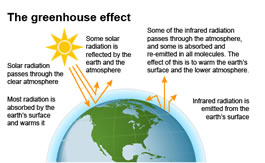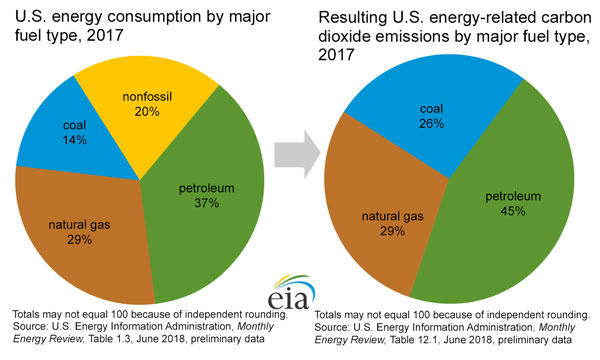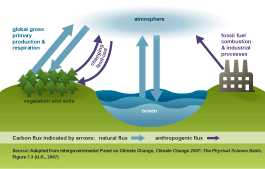Greenhouse Gases Basics
Did you know?
Without naturally occurring greenhouse gases, the earth would be
too cold to support life as we know it. Without the greenhouse effect, the
average temperature of the earth would be about -2°F rather
than the 57°F we currently experience.
Many of the chemical compounds in the earth's atmosphere act as greenhouse gases. When sunlight strikes the earth’s surface, some of it radiates back toward space as infrared radiation (heat). Greenhouse gases absorb this infrared radiation and trap its heat in the atmosphere, creating a greenhouse effect that results in global warming and climate change.
Many gases have greenhouse properties. Some gases occur naturally and are also produced by human activities. Some, such as industrial gases, are only human made.
What are the types of greenhouse gases?
Several major greenhouse gases that are the result of human activity are included in U.S. and international estimates of greenhouse gas emissions:
- Carbon dioxide (CO2)
- Methane (CH4)
- Nitrous oxide (N2O)
- Industrial gases:
- Hydrofluorocarbons (HFCs)
- Perfluorocarbons (PFCs)
- Sulfur hexafluoride (SF6
- Nitrogen trifluoride (NF3
Where Greenhouse Gases Come From
In the United States, most of the emissions of human-caused (anthropogenic) greenhouse gases (GHG) come primarily from burning fossil fuels—coal, hydrocarbon gas liquids, natural gas, and petroleum—for energy use. Economic growth (with short-term fluctuations in growth rate) and weather patterns that affect heating and cooling needs are the main factors that drive the amount of energy consumed. Energy prices and government policies can also affect the sources or types of energy consumed.
Carbon dioxide
In 2016, emissions of carbon dioxide (CO2) produced from burning fossil fuels for energy were equal to 76% of total U.S. anthropogenic GHG emissions (based on global warming potential) and about 94% of total U.S. anthropogenic CO2 emissions. Carbon dioxide emissions from other anthropogenic sources and activities were about 5% of total GHG emissions and about 6% of total CO2 emissions.
The energy connection
Fossil fuels consist mainly of carbon and hydrogen. When fossil fuels are burned, oxygen combines with carbon to form CO2 and with hydrogen to form water (H2O). These reactions release heat that we use for energy. The amount of CO2 produced depends on the carbon content of the fuel, and the amount of heat produced depends on the carbon and hydrogen content. Because natural gas, which is mostly methane (CH4), has a high hydrogen content, combustion of natural gas produces less CO2 for the same amount of heat produced from burning other fossil fuels. For example, for the same amount of energy produced, burning natural gas produces about half of the amount of CO2 produced by burning coal.
Nearly half of U.S. energy-related CO2 emissions are from petroleum use
In 2017, about 45% of U.S. energy-related carbon dioxide emissions came from burning petroleum fuels, 29% came from burning natural gas, and 26% came from burning coal.
Effect on the Climate
Grade: A. Ready
Greenhouse gas emissions and atmospheric concentrations have increased over the past 150 years
Global carbon dioxide emissions and atmospheric concentrations (1752–2014)

Click to enlarge »
Emissions of several important greenhouse gases that result from human activity have increased substantially since large-scale industrialization began in the mid-1800s. Most of these human-caused (anthropogenic) greenhouse gas emissions were carbon dioxide (CO2) from burning fossil fuels.
Concentrations of CO2 in the atmosphere are naturally regulated by many processes that are part of the global carbon cycle. The flux, or movement, of carbon between the atmosphere and the earth's land and oceans is dominated by natural processes like plant photosynthesis. Although these natural processes can absorb some of the anthropogenic CO2 emissions produced each year (measured in carbon equivalent terms), starting in about 1950, emissions began exceeding the capacity of these processes to absorb carbon.
This imbalance between greenhouse gas emissions and the ability for natural processes to absorb those emissions has resulted in a continued increase in atmospheric concentrations of greenhouse gases. Concentrations of CO2 in the atmosphere have increased by about 40% since the mid-1800s.
Greenhouse gases warm the planet
Scientists know with virtual certainty that increasing greenhouse gas concentrations tend to warm the planet.
Assessments by the Intergovernmental Panel on Climate Change (IPCC) suggest that the earth’s climate warmed 0.85 degrees Centigrade (1.53 degrees Fahrenheit) between 1880 and 2012 and that human activity affecting the atmosphere is likely an important driving factor. The IPCC’s Fifth Assessment Report (Summary for Policymakers) states, "Human influence has been detected in warming of the atmosphere and the ocean, in changes in the global water cycle, in reductions in snow and ice, in global mean sea level rise, and in changes in some climate extremes. It is extremely likely that human influence has been the dominant cause of the observed warming since the mid-20th century."
Did you know?
In 2016, fossil fuels were the source of about 81% of U.S. primary energy consumption and about 94% of total U.S. carbon dioxide emissions from human activity.
The report later states, "It is extremely likely that more than half of the observed increase in global average surface temperature from 1951 to 2010 was caused by the anthropogenic increase in greenhouse gas concentrations and other anthropogenic forcings together."
The report also states, “Concentrations of CO2, CH4, and N2O now substantially exceed the highest concentrations recorded in ice cores during the past 800,000 years. The mean rates of increase in atmospheric concentrations over the past century are, with very high confidence, unprecedented in the last 22,000 years.”
Outlook for Future Emissions
Carbon dioxide emissions are expected to increase
In the U.S. Energy Information Administration's International Energy Outlook 2017 (IEO2017) Reference case, world energy-related carbon dioxide (CO2) emissions rise from 33.9 billion metric tons in 2015 to 36.4 billion metric tons in 2030 and to 39.3 billion metric tons in 2040—an increase of 16% over that period.







